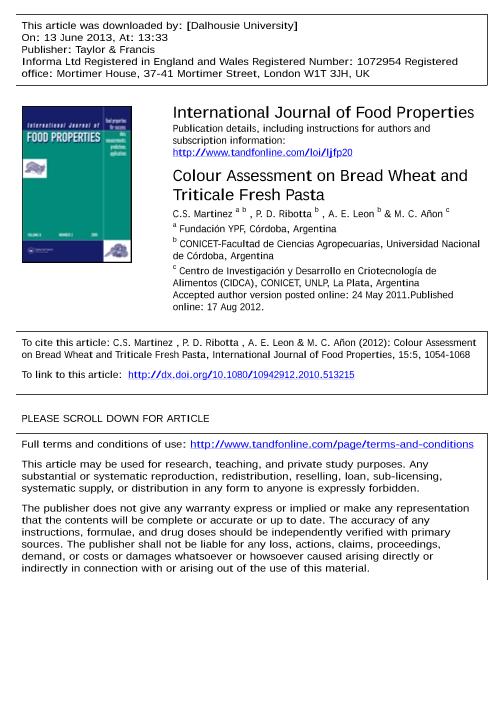Artículo
Colour assessment on bread wheat and triticale fresh pasta
Fecha de publicación:
09/2012
Editorial:
Taylor & Francis
Revista:
International Journal Of Food Properties
ISSN:
1094-2912
e-ISSN:
1532-2386
Idioma:
Inglés
Tipo de recurso:
Artículo publicado
Clasificación temática:
Resumen
Although durum wheat is the cereal of choice for pasta production, in many areas of Argentina pasta is made from bread wheat, since durum wheat is cultivated only in a small region of the country. The purpose of this work was to determine the influence of different bread flours on the colour of laminated fresh pasta. Triticale flour was also studied. In addition, ash, protein, and protein fractions of each flour were measured. Also, the formulation was modified using different gluten, starch, and water concentrations. Pasta lightness and redness were affected mainly by the ash content, while yellowness was affected by the protein content of different flours. A similar effect was found when the formulation was substituted for starch and gluten, due to protein dilution and concentration, respectively. Albumins and globulins correlated with a* component, while gliadins, soluble and insoluble glutenins correlated with b* component; however, only glutenins presented correlation with colour score (CS = [L* + (b*×2)]/20). The greatest amount of water added to the dough produced a decrease of lightness and an increase of redness and yellowness of pasta samples. The overall ANOVA revealed that the greatest sources of variation for pasta colour were the different flours used, in comparison with the effect of starch and gluten substitution, and with the addition of different amounts of water. © 2012 Copyright Taylor and Francis Group, LLC.
Palabras clave:
BREAD WHEAT FLOUR
,
COLOR
,
FRESH PASTA
,
GLUTEN
,
STARCH
,
WATER
Archivos asociados
Licencia
Identificadores
Colecciones
Articulos(ICYTAC)
Articulos de INST. DE CIENCIA Y TECNOLOGIA DE ALIMENTOS CORDOBA
Articulos de INST. DE CIENCIA Y TECNOLOGIA DE ALIMENTOS CORDOBA
Citación
Martinez, C. S.; Ribotta, Pablo Daniel; Leon, Alberto Edel; Añon, Maria Cristina; Colour assessment on bread wheat and triticale fresh pasta; Taylor & Francis; International Journal Of Food Properties; 15; 5; 9-2012; 1054-1068
Compartir
Altmétricas




